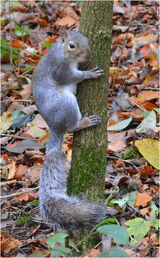Nature
Nature photography depicts living, untamed animals and uncultivated plants in a natural habitat, geology and the wide diversity of natural phenomena.
Photographs of animals, which are domesticated, and photographs of cultivated or hybrid plants are ineligible.
Minimal evidence of humans is acceptable for nature subjects, such as barn owls or storks adapting to an environment modified by humans, or natural forces, like hurricanes or tidal waves, reclaiming it.
Any manipulation or modification is limited to minor retouching and must not alter the truth of the original scene.
Nature photographers frequently take pictures of animals under “controlled conditions” in order to record species or behaviour that would be very difficult or impossible to record in the wild. This might even include microscopic subjects, which have to be anaesthetised. Such photographs are eligible for entry to ACC, YPU and PAGB Competitions.
Animals in reserves and wildlife parks and zoos are permitted provided there is minimal evidence of humans. So too are "falconer's" birds although, of course, only minor retouching is permitted which would not, for example, include removing jesses in post-processing. Also permitted are pictures of “wild” flowers growing in parkland or “wild” gardens provided these have not been modified by such cultivation.
It is obvious that creatures showing poorer condition because of their captivity are likely to be marked less favourably by nature judges.
Photographs of animals, which are domesticated, and photographs of cultivated or hybrid plants are ineligible.
Minimal evidence of humans is acceptable for nature subjects, such as barn owls or storks adapting to an environment modified by humans, or natural forces, like hurricanes or tidal waves, reclaiming it.
Any manipulation or modification is limited to minor retouching and must not alter the truth of the original scene.
Nature photographers frequently take pictures of animals under “controlled conditions” in order to record species or behaviour that would be very difficult or impossible to record in the wild. This might even include microscopic subjects, which have to be anaesthetised. Such photographs are eligible for entry to ACC, YPU and PAGB Competitions.
Animals in reserves and wildlife parks and zoos are permitted provided there is minimal evidence of humans. So too are "falconer's" birds although, of course, only minor retouching is permitted which would not, for example, include removing jesses in post-processing. Also permitted are pictures of “wild” flowers growing in parkland or “wild” gardens provided these have not been modified by such cultivation.
It is obvious that creatures showing poorer condition because of their captivity are likely to be marked less favourably by nature judges.

2nd Place - with Amorous Giraffes By Liakat Parapia

3rd Place - with Juvenile Starlings Been Feed By Peter Evens

Highly Commended - Buffalo with Oxpecker By Dave Varney

Highly Commended - Hedgehog By Jean Middleton

Commended Red Deer Stag, Fountains Abbey By Peter Evens

Commended Ready for take off By Chris Owens

Commended Red Kite Calling By Dave Varney

1st Place - with Black-Headed Gull By Peter Evens

1st - Robin - Harry Ferraby

2nd - Alpine Wild Goats - Derek Middleton

3rd - Nigella, flower & seed pod - Chris Owens

Commended - Mother and baby giraffe, Aberdare National Park, Kenya - Liakat Parapia

Commended - Now that's a tasty meal - Leopard, Ruaha NP, Tanzania - Dave Varney

Commended - Perfect Specimen - Chris Hyslop

Commended - Water Monitor, Krabi - Dave Varney

Highly Commended - Female Common Merganser - Jean Middleton

1st - Pauline Marshall - Iguassu Falls

2nd - Tony Collinson - Black Necked Grebe

3rd - Harry Ferraby - Mallard Ducklings

Highly Commended - Chris Owens - Four Spot Chaser

Highly Commended - Harry Ferraby - Female Common Darter

Highly Commended - Mike Woodcock - Fractal Fern

Highly Commended - Peter Jeffery - I think he's seen me!

Highly Commended - Sue Mitchell - Silver Argiope

1st - Mike Woodcock - Grey Squirrel

2nd - Pete Evans - Beautiful Demoiselle Dragonfly

3rd - John Kennedy - Desert Pine

Commended - John Kennedy - Grey Heron

Commended - Liakat Parapia - Hippopotamus,Lake Naivasha,Kenya

Highly Commended - Pauline Marshall - Painted Lady Butterfly

Commended - Chris Owens - Bracket Fungi

Commended Dave Varney - Homeward Bound'. Young male Lion, Ruaha NP, Tanzania

Commended Dave Varney - 'That Bee thinks I cant see him!' Caiman, Northern Pantanal, Brazil

1st - Dave Varney 'The 3 Amigos'. Guira Cuckoos, Brazil

2nd -Pauline Marshall - Butterfly

Highly Commended - Dave Varney - Giant Otter, Pantanal, Brazil

3rd Dave Varney Shag, Staple Island, UK

Commended Jean Middleton Sparrow Hawk with prey

Commended Pauline Marshall Deer, Scotland

1st Dave Varney Leopard, Ruaha NP, Tanzania

